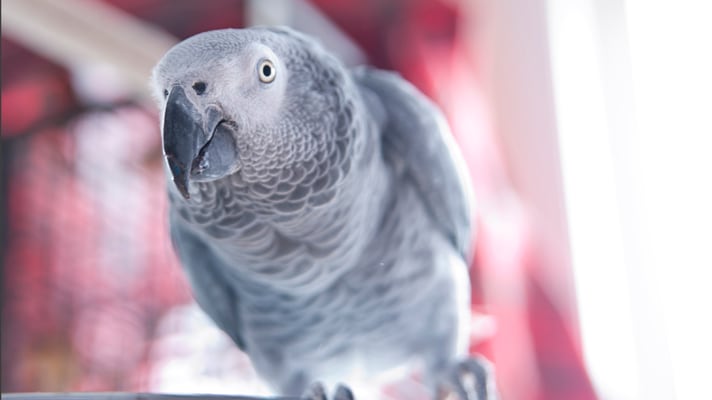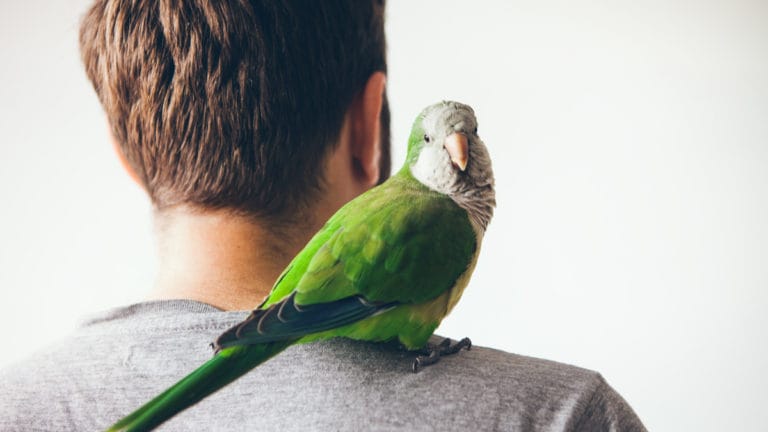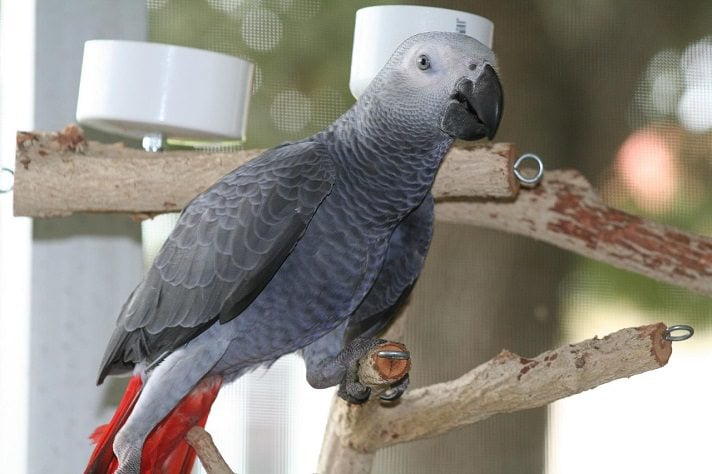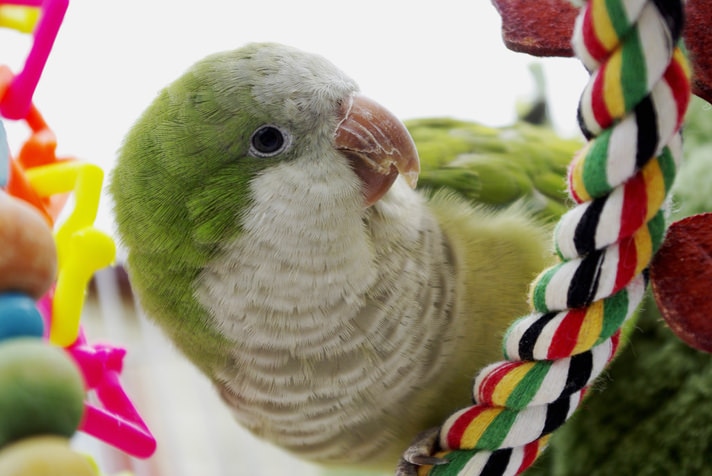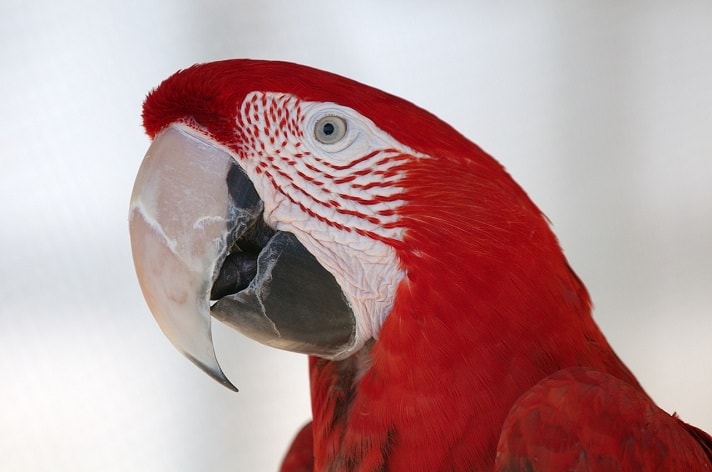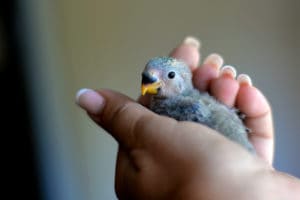Check out the top ten African grey parrot questions answered below:
1. Are there two types of African grey parrots?
Yes, there are two African grey parrot species: the Congo African grey and the timneh African grey. The Congo African grey parrot (Psittacus erithacus erithacus) weighs 435 to 500 grams, measures 13 inches in size and has a red tail. The timneh African grey parrot (Psittacus erithacus timneh) weighs 300 to 375 grams, measures 9 inches in size and has a horn-colored upper mandible and a maroon tail. In terms of behavior, owners sometimes say timneh African grey parrots are more easy-going than Congo African grey parrots.
2. What should my African grey parrot eat?
Proper nutrition is found in balance. Your African grey parrot’s diet should consist of a selection of grains, fresh fruits and vegetables, and a base of a formulated food (pellets). Pet African grey parrot lifestyles differ greatly from wild African grey parrots, so some people say owners need not try to duplicate this diet, such as by giving their pet African greys palm oil because African grey parrots in the wild eat roots of the African oil palm. Talk to your avian veterinarian about the proper proper African grey parrot bird food.
3. Do African grey parrots talk?
Yes, many African grey parrots can—and do—talk! Owners and bird aviculturists often count African grey parrots among the best talkers. The most famous example is African grey parrot Alex, the subject of Irene Pepperberg’s published research on development conducted at Brandeis and Harvard universities. Alex could identify about 50 objects by color, shape and matter and used language with intentionality. With regular training sessions, encouragement and patience, your African grey parrot might talk. The exceptions always prove the rule, however, and some African grey parrots will simply mimic sounds and make their own noises.
4. What kind of pet bird cage should I get for my African grey parrot?
As with all pet birds, the bigger the pet bird cage, the better. A 3-feet by 2-feet by 4-feet pet bird cage with 3/4- to1-inch bar spacing is good for African grey parrots — some experts recommend 3/4 inch spacing for a timneh African grey parrot. Horizontally oriented bars in the pet bird cage can allow African grey parrots to climb on the sides. Experts recommend a large door because some African greys can be fearful or reluctant of coming in or out of a pet bird cage. Some veterinarians suggest a pet bird cage that is wider than it is tall because falls from great heights can be particularly damaging to African grey parrots.
5. What kind of pet bird cage accessories and pet bird toys should I get my African grey parrot?
African grey parrots develop stability and confidence when they have things to do, including playing with pet bird toys. Destructible toys and perches, foraging activities and exercise opportunities all keep your pet African grey parrot happy and well-adjusted. Another way to enrich your African grey parrot’s life is to provide it with the kind of drenching showers it’s used to in the wild. In the home setting, you can recreate this by misting your pet bird. Your pet African grey might not like taking a bath at first, but there are many tips to teaching it to like to bathe.
6. How can I tell if my African grey parrot is sick?
African grey parrots are susceptible to a few particular illnesses. Feather color changes in your African grey parrot could indicate damaged feather follicles from:
- feather picking
- medication administered when your pet bird molted
- malnutrition
- liver disease
- kidney problems
Monitor your African grey parrot’s food and water intake, as well as its droppings, and bring your pet African grey in for regular avian veterinarian checkups to keep you aware of your pet African grey’s health.
7. What’s the best way to train my African grey parrot?
African grey parrots respond well to positive reinforcement and respect. Whether trick-training or teaching your bird to speak, make the experience enjoyable and rewarding by offering your bird a treat or praise when it accomplishes its goal and by approaching it when it’s in the right mood.
8. How do I tell if my African grey parrot is male or female?
You can distinguish between the sexes with a few subtle visual clues, but the best way to determine the sex of your pet African grey parrot is through a DNA test. Visible indicators appear on older (more than 18 months) African greys and include differences in the eyes and under-tail coverts (directly under the tail feathers). Female African grey feathers will have gray edges and males will have solid red feathers with occasional white hairline edges.
9. I’ve heard African grey parrots don’t like change. Is that true?
Yes, if they are conditioned to. Although an African grey parrot can become controlling over its territory, owners can accustom their pet parrots to change with slight, regular alterations to pet bird cages. By increasing tolerance to change in this way, you can control aggressiveness and fearfulness.
10. I’ve heard African grey parrots are more prone to feather picking. Is that true?
African grey parrots have been known to feather pick; however, some environmental and behavioral precautions can prevent this condition. Experts recommend giving African greys quiet time and opportunities to get away by making a corner of your African grey’s pet bird cage private. As always, a pet bird cage stocked with toys and things to do will keep an African grey happy. Some over-the-counter bird medication can also help prevent feather picking.
Posted By: Chewy Editorial
Featured Image: via shrutebucks/iStock/ThinkStock
Share:
